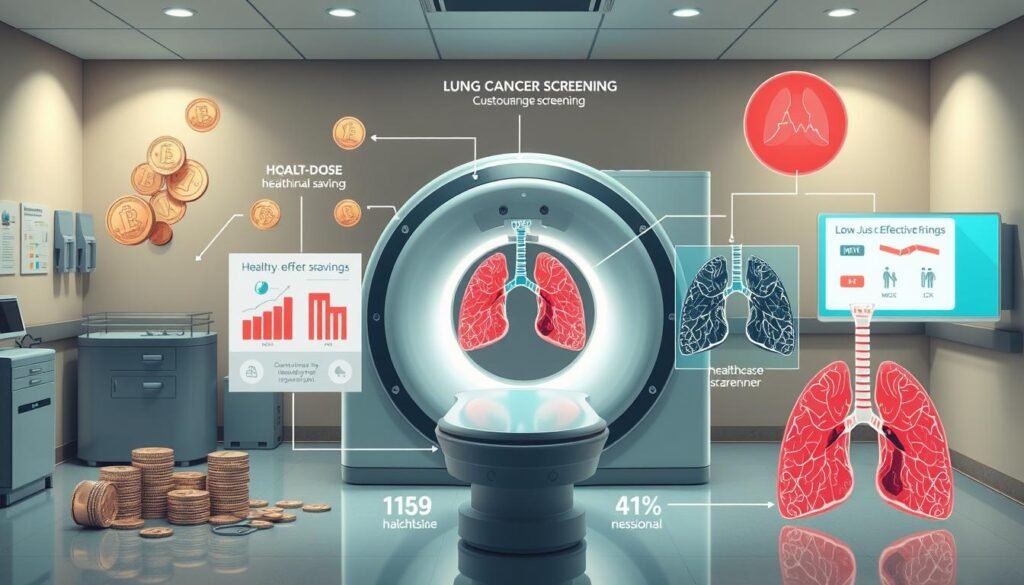Lung cancer screening can lower death rates by at least 20% in those at high risk. However, low-dose CT scans for lung cancer also come with challenges. It’s essential to know these risks, as lung cancer is the top killer in the U.S.
This guide helps you understand low-dose CT scans better. It talks about who should get screened, what false positives mean, and the lung cancer risks from screenings. We aim to help you weigh the pros and cons. This way, you can make choices that are best for your health.
Key Takeaways
- Lung cancer screening can lead to significant reductions in mortality among high-risk groups.
- Low-dose CT scans pose risks such as radiation exposure and false positives.
- Eligibility for screening is often based on age and extensive smoking history.
- Overdiagnosis may lead to unnecessary treatments for non-threatening conditions.
- Insurance plans generally cover lung cancer screening, but follow-up tests might incur additional costs.
Understanding Lung Cancer and Its Prevalence
Lung cancer is a major health issue in the United States. It leads to many cancer deaths. About 228,820 new cases were found in 2020, and around 135,720 people died from it. This makes it the top cause of cancer deaths. Knowing the risks can help people make better health choices, including getting screened.
Statistics on Lung Cancer Incidence
Lung cancer is the most common cancer in the United States. Smoking causes about 87% of lung cancer deaths. The more you smoke, the higher your risk gets. The American Cancer Society suggests yearly screenings for those 50 to 80 years old with a heavy smoking history. If smoking rates don’t drop, more than 100,000 people could die from lung cancer by 2035.
Screening too much can worry patients, but new methods like the LYFS-CT model could help. It aims to find who really needs screening.
Risk Factors for Lung Cancer
Knowing lung cancer risks is key to prevention. Smoking makes you 20 times more likely to get lung cancer. The average age of diagnosis is around 70. Even if you’ve quit smoking, you’re still at risk. It can take 15 years after quitting for the risk to lower significantly. Radon exposure indoors is also a big risk, causing 25% of deaths among non-smokers.
Detecting lung cancer early can save lives, especially in high-risk groups. Methods like liquid biopsies and scans are key. Teaching people about risks and screening can lower lung cancer rates and improve health.
The Basics of Low-Dose CT Lung Cancer Screening
Low-dose CT scanning, or LDCT, is a key method for checking lungs for cancer. It uses less radiation but still gets clear pictures. This screening is for people who have a high risk from smoking or other causes. Knowing how this CT scan works is key for patients and doctors alike.
What is Low-Dose CT Scanning?
LDCT uses cutting-edge tech to get detailed lung images. It gives off much less radiation—about 1.4 millisieverts (mSv) compared to standard CT scans’ 7 mSv. Since we all get 3 to 5 mSv a year from natural sources, LDCT’s lower radiation makes it safer for regular checks.
How Does LDCT Work?
The LDCT scan is quick and doesn’t hurt. Patients lie down as the machine takes 3D pictures of their lungs. These pictures are crucial for finding any early signs of trouble. LDCT can spot small lung changes, possibly pointing to cancer. The American Cancer Society says LDCT could prevent up to 60,000 US deaths a year. People 50 to 80 who smoked a lot are advised to get these scans yearly.
Eligibility Criteria for Lung Cancer Screening
Understanding who should get screened for lung cancer is very important. It helps find people who might have lung cancer early. Mostly, people between 50 and 80 who have smoked a lot are considered. Picking the right people for screening is about looking at their smoking history and health.
Recommended Age Range and Smoking History
Screening is for those 50 to 80 years old. They should have a history of smoking about 20 pack-years. Pack-years mean smoking a pack a day for a year. This includes people who smoke now or stopped in the last 15 years. Since smoking causes most lung cancers, this history is key to decide who gets screened.
Health Considerations Before Screening
It’s important patients don’t show symptoms of lung cancer to be screened. Doctors also look at other health issues. They want to make sure the screening won’t do more harm than good. Doing a complete health check helps decide this.
| Criteria | Details |
|---|---|
| Age Range for Screening | 50 to 80 years |
| Smoking History | Minimum 20 pack-years, current smokers or those who quit within the last 15 years |
| Asymptomatic Status | No signs or symptoms of lung cancer |
| Health Assessment | Evaluate serious health issues affecting life expectancy or treatment options |
Risks of Low-Dose CT Lung Cancer Screening
Low-dose CT lung cancer screening helps find cancer early. But, it’s important to know about the risks. Knowing these can help you make a smart choice about screening.
Radiation Exposure Concerns
One big worry with low-dose CT scans is radiation exposure. A single scan’s radiation is half of what you’d get from nature in a year. But, getting scanned many times can add up. This makes people wonder about its safety over time, especially for those at high risk.
False Positives and Their Implications
False positive results are another issue. They happen to 25% of people screened who don’t have lung cancer. This means nearly 250 out of 1,000 at-risk patients get abnormal results. This leads to more tests that can cause worry and stress. Sometimes, 2.5% might have surgeries or biopsies, which can be risky or even deadly.
Understanding Overdiagnosis
Overdiagnosis is also a big problem. Studies show at least 20% of found cancers may not need treatment. They wouldn’t harm you because they grow slowly or not at all. The risks of low-dose CT are not just physical. They also affect your mental health and can lead to unnecessary treatments. Health groups say knowing these risks is very important. For more info, visit here.

Patient Compliance and Screening Uptake
The participation rates in lung cancer screening remain low despite the benefits shown by studies. This is due to factors that influence people’s decision-making. These factors include common myths and a lack of knowledge about screening. By discussing these issues, we can help more people agree to screening tests.
Reasons for Low Screening Participation
Several reasons keep people from taking part in lung cancer screenings. Main obstacles include:
- Misconceptions about Risks: Many think the screening is more dangerous than it is.
- Lack of Awareness: Some don’t know about low-dose CT scans and their purpose.
- Personal Reluctance: Anxiety about what the screening might reveal causes some to hesitate.
- Access to Healthcare: For some, getting to screenings is hard due to lack of transportation or money.
Importance of Patient Education
Teaching patients is key to getting more people screened. Good education programs can fill in the knowledge gaps about lung cancer screening. Clear info and support boost participation and ensure patients understand:
- The process of low-dose CT screening: Explaining how it works and its importance helps patients.
- Follow-up care: Teaching about follow-up visits increases the number of people who keep them.
- Smoking cessation resources: Showing how to get help to stop smoking can decrease lung cancer risks.
A study with 505 patients showed that 88.1% used a decision aid during discussions. This led to better choices about screening. Those who tested positive but didn’t have cancer showed high follow-up rates. But, only 23.7% with negative results came back for yearly check-ups. This highlights the need to better educate patients to overcome screening barriers.
The Cost-Effectiveness of Lung Cancer Screening
Looking at lung cancer screening costs shows interesting patterns. It’s especially about how LDCT screening reduces death rates, considering the costs. Studies show the cost for a quality life year gained ranges from $110,000 to $169,000 for those at high risk. This highlights a key part of LDCT screening’s cost analysis.
Evaluating Healthcare Costs
Healthcare costs are a big part of thinking about lung cancer screening. For instance, a model from different trials estimated annual screening costs. These costs change based on how much someone has smoked. When more people get screened, the costs can drop under $75,000 per quality life year. This shows that more screening could make the program more cost-effective.
Insurance Coverage for LDCT Screening
Insurance coverage is crucial for getting to lung cancer screening. Many insurers follow what groups like the U.S. Preventative Services Task Force recommend. This support for LDCT screening helps people go for preventive care. This is really important for those at high risk. Knowing how insurance affects getting screened shows why good health policies matter. For more on the costs and benefits of lung screening, check this article.

| Screening Participation Scenario | Cost per QALY ($) | Mortality Reduction (%) |
|---|---|---|
| Standard Participation | $110,000 – $169,000 | 20% (NLST) |
| Increased Participation | Below $75,000 | 24% (NELSON, men) |
| Combined Screening/Cessation Therapy | $130,500 – $159,700 | Varies |
Guidelines for Lung Cancer Screening
Lung cancer screening has changed a lot lately. Health groups like the U.S. Preventive Services Task Force (USPSTF) and the American Cancer Society have updated guidelines. They help decide who should get screened to find lung cancer early. Now, more people at risk can get an annual low-dose CT scan.
Recommendations from Health Organizations
The USPSTF now says adults 50 to 80 who smoked at least 20 pack-years should get a yearly CT scan. This is a change from the old rule of 30 pack-years. With this update, twice as many people could get screened to catch lung cancer early. People should stop screening if they haven’t smoked for 15 years or if other health problems would affect their life expectancy or if they’ve had lung surgery that cured their disease. Following these guidelines is key to lowering death rates from lung cancer.
Importance of Shared Decision-Making
Shared decision-making is crucial in healthcare. It makes sure patients get care that matches their needs and values. Talking with patients about the pros and cons of lung cancer screening helps them make choices that fit their health goals. Health groups emphasize the need for counseling to help people understand before they decide on CT screening. For more on these guidelines, check out the lung cancer screening guidelines.
The Role of Smoking History in Screening Decisions
Smoking history is key in deciding lung cancer screening eligibility. It takes into account how much tobacco a person has used in their life. The risk of lung cancer increases with the amount of tobacco smoked.
Assessing Cumulative Tobacco Exposure
Cumulative tobacco exposure looks at how long and how much a person has smoked. Health professionals use pack-years to measure it. For example, smoking a pack a day for 20 years equals 20 pack-years. Adults 50 to 80 years old with a 20 pack-year history should get screened yearly, according to the USPSTF.
Impact of Quitting on Screening Eligibility
Quitting smoking changes lung cancer risk levels. However, former smokers remain at increased risk for years. Those who’ve quit for 15 years may not need routine screenings anymore. Supporting people in quitting smoking is key to reducing lung cancer risk.

Screening Follow-Up and Management of Lung Nodules
Getting an abnormal result from a lung cancer screening can be overwhelming. It’s important for patients to know the next steps. The follow-up for lung screening includes watching and managing lung nodules closely. Doctors and patients must communicate well to decide if more interventions are needed based on the nodules’ traits.
What Happens After an Abnormal Result?
After an abnormal result, managing lung nodules is systematic. Doctors look at the size, density, and growth of the nodules. They set follow-up times, often yearly if the nodules seem harmless. Sometimes, a biopsy or surgery is needed for nodules that raise concerns.
- Reviewing nodule size, density, and growth rate as these factors influence the management plan.
- Establishing follow-up intervals tailored to the patient’s specifics, usually every 12 months if benign.
- Determining if a biopsy or surgical intervention is necessary, especially for nodules showing significant concern.
Care is personalized, considering a patient’s health history and nodule details. Consensus statements during the pandemic show how to manage abnormal results safely and effectively.
Standardized Reporting with Lung-RADS
The Lung-RADS system has changed how lung nodules are managed. It helps doctors make consistent decisions and reduces unnecessary anxiety for patients. Not every low-dose CT scan is covered by Lung-RADS. Yet, its use has lessened the need for unneeded procedures.
Lung-RADS sorts findings, making the follow-up process more straightforward. For instance:
| Lung-RADS Category | Description | Recommended Follow-Up |
|---|---|---|
| 1 | No nodules | No follow-up necessary |
| 2 | Benign findings | Annual screening |
| 3 | Probably benign nodules | Follow-up in 6 months |
| 4A | Suspicious nodules | Follow-up in 3 months or biopsy |
| 4B | Highly suspicious nodules | Immediate biopsy |
| 5 | Likely malignant nodules | Urgent biopsy or surgery |
Using Lung-RADS helps doctors talk clearly and plan care better. This leads to improved outcomes for patients. Knowing the specific nature of nodules is key in getting the right treatment. Radiation therapy may also be part of managing lung nodules when needed.
Conclusion
Low-dose CT lung cancer screenings have their risks and benefits. Studies like the National Lung Screening Trial show they can reduce lung cancer deaths. But, people undergo a significant amount of radiation over ten years. This increases their risk of developing lung cancer, depending on their age and gender.
It’s important to understand both the good and bad sides of low-dose CT screenings. Studies like COSMOS show there’s a real risk of radiation-caused cancers. That’s why high-risk individuals need to talk with their doctors. They need to balance the risks with the benefits of catching cancer early.
Deciding on LDCT screening requires knowing all the facts. This knowledge lets people make choices that fit their health situation and risk level. Being informed about the risks of lung cancer screening is crucial for taking care of one’s health proactively.